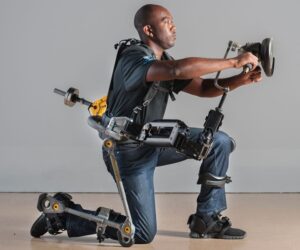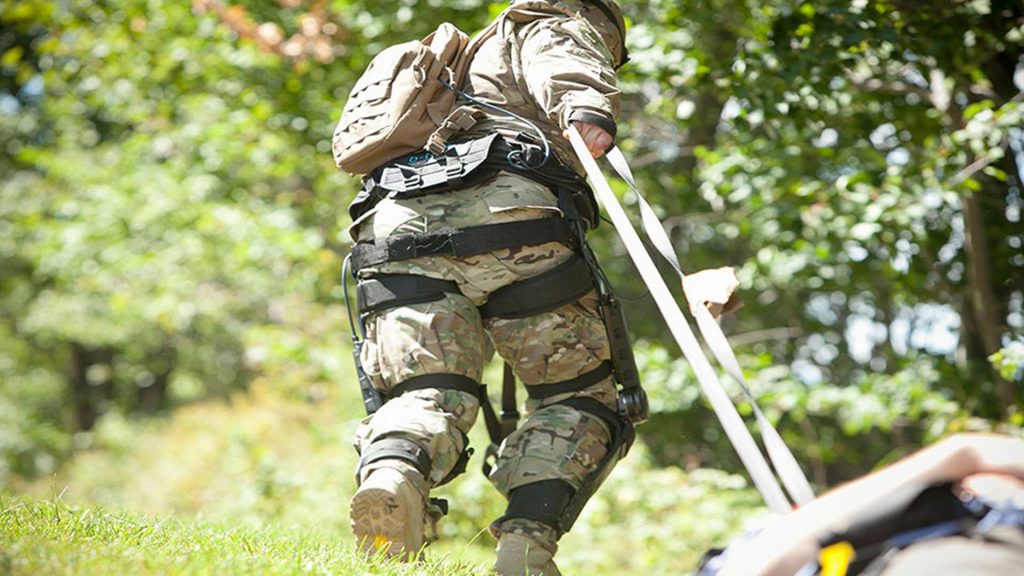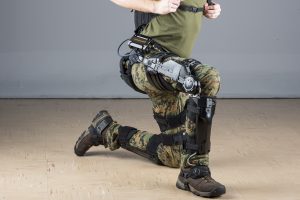ΣΧΟΛΙΟ ΙΣΤΟΛΟΓΙΟΥ: Οι μπαταρίες δεν έχουν μεγάλη διάρκεια ζωής....επίσης οι επαναφορτιζόμενες μπαταρίες ιόντων λιθίου περιέχουν εύφλεκτο ηλεκτρολύτη.Όταν διαρρηγνύοναι, βραχυκυκλώνουν και εκφορτίζονται αμέσως ,προκαλώντας ανάφλεξη ή / και έκρηξη του εύφλεκτου ηλεκτρολύτη.
The Lockheed Martin ONYX doesn't seem particularly high tech when it's surrounded by displays of mini-drones, wheeled robots, and VR simulators here. But lean in close and listen as the soldier bends his knee.
PENTAGON COURTYARD: The Lockheed Martin ONYX doesn’t seem particularly high tech when it’s surrounded by displays of mini-drones, wheeled robots, and VR simulators here at today’s Close Combat Lethality showcase. At first glance, ONYX looks like an unduly complicated leg brace.
But lean in close and listen as the soldier bends his knee. Hear that faint electric whine? It’s a compact actuator boosting his strength with every move. ONYX isn’t sci-fi powered armor like Iron Man, or the heavily protected TALOS suit that Special Operations Command’s developing, but it is, literally, a big step towards them: a powered exoskeleton for the legs.
It’s been a long time coming. Maxwell has personally worked on exoskeletons for 10 years. Back then, the aptly named HULC was the pinnacle of the technology. The Human Universal Load Carrier looked a lot more advanced than ONXY. It was a sci-fi monstrosity of metal tubing that extended from a motorized backpack over the wearer’s legs and shoulders, allowing you to carry heavy weights.
The problem was that wearing HULC wore you out. The exoskeleton’s elaborate mechanisms couldn’t match the natural variation in a human’s movements over uneven ground, so wearers ended up fighting the exoskeleton and exhausting themselves. Since endurance is more important to infantry than raw power, Lockheed decided to go back to basics.

FORTIS industrial exoskeleton
On the move, the exoskeleton takes weight off the wearer’s body, reducing fatigue and the risk of injury without limiting range of motion. “I can do everything I did before,” the soldier demonstrating ONYX said, before sprinting back and forth by way of demonstration. (He’d put on the exoskeleton for the first time just two days before). At rest, the soldier showed us, he can squat and put all his weight on the exoskeleton, as if sitting on a chair.

No, the ONYX exoskeleton doesn’t help your legs run faster or your arms lift heavy weights. Upper-body enhancements may come in the future — Maxwell’s team is studying them — but so far they seem to offer a lot less return on the investment. Everyone uses their legs all the time, especially hard-marching infantry, and it’s your legs that take the full weight of whatever you’re carrying, while the arms aren’t used as constantly or as hard. Conversely, what arms can do that legs can’t is flex through a much wider range of motion; if you don’t want your exoskeletons to restrict that — say, when a soldier is trying to aim — you need three times as many actuators for the arms as for the legs.
By taking a minimalist legs-only approach, Maxwell & co. have kept the weight of ONYX under 14 pounds. The external batteries add another six pounds for eight hours of operation, or 12 pounds for 16 hours, but Lockheed and the Army’s Natick Soldier Center agree that isn’t good enough. Finding lighter batteries is a major focus for military research, as it has been for decades.

Lockheed Martin’s ONYX exoskeleton
Lockheed also needs to ruggedize the exoskeleton so its joints and actuators are proof against water, dust, and shock, Maxwell said. That done, this December, field testing can begin. If ONYX can make it through three rounds of rigorous workouts, it might join mini-drones, augmented reality, and new weapons as part of a coming revolution in the infantry.
ΠΗΓΗ

Δεν υπάρχουν σχόλια:
Δημοσίευση σχολίου